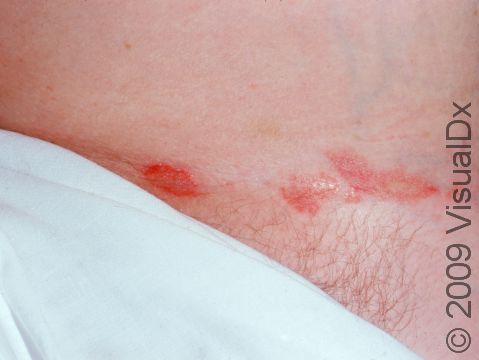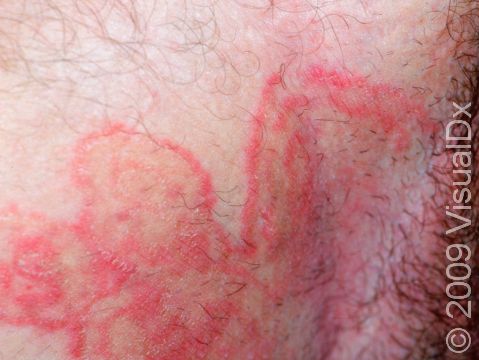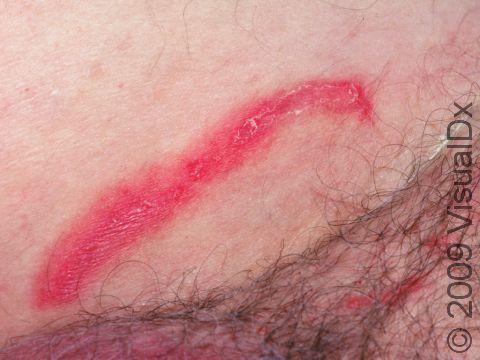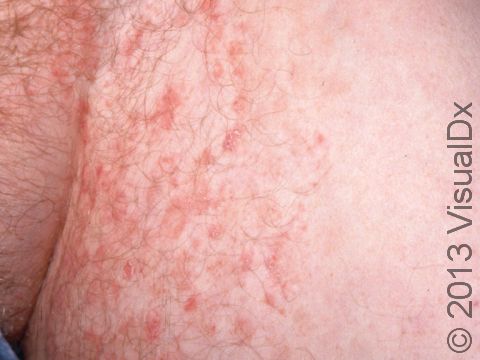Jock Itch (Tinea Cruris)
Tinea cruris, commonly known as jock itch, is a superficial fungal infection of the skin, often on both sides of the body where the thigh joins the abdomen, known as the groin. It is often spread to the groin from a fungal infection on another body location, often the feet (called tinea pedis, or athlete’s foot).
Who's At Risk?
Jock itch is very common around the world and is especially common in warm, moist regions as the fungus thrives in such conditions.
People who wear tight clothing for extended periods, share clothing, participate in athletics, or are overweight or have diabetes are more often affected with jock itch. It is common in adult men.
Signs & Symptoms
Large, round plaques (raised areas of skin larger than a thumbnail) with bumpy, scaling edges occur in the groin and may extend down the inner thigh or onto the belly or buttocks areas. In lighter skin colors, the border can be pink or red, whereas in darker skin colors, it can be dark red, purple, brown, or grayish. Jock itch is usually not present on the genitals. It is usually very itchy.
Self-Care Guidelines
Over-the-counter antifungal creams such as miconazole (eg, Micatin), clotrimazole (eg, Lotrimin AF), terbinafine (eg, Lamisil), or tolnaftate (Tinactin) are very effective at treating jock itch. Apply the cream to each plaque and to the skin 2 cm beyond the border of the affected skin twice daily for 2-3 weeks. You may still see flat, brown areas of discoloration for several weeks, but these do not need to be treated as long as there is no longer itching or bumps and scales in the area.
Check your feet and if you see scaling or moist plaques in between your toes, this is foot fungus that should also be treated.
Reinfection can be prevented. Keep the area cool and dry by drying the body thoroughly after bathing and by wearing loose cotton clothing. Wash your clothing and linens in hot water. If you think you also have athlete’s foot, use a separate towel for your feet and try to keep your feet dry by avoiding wearing shoes for long periods and by treating shoes with antifungal powder. Clean your bath / shower with bleach and floors with an appropriate cleaner to kill any fungal spores. You should avoid sharing clothing with others, and you should wear footwear in public bathrooms, showers, and gyms.
Treatments
Your medical professional may scrape some scales onto a slide and examine them under a microscope.
If you have jock itch, your medical professional may prescribe an antifungal cream or pill.
Visit Urgency
If you see no improvement after 2 weeks of self-care, see a medical professional.
References
Bolognia J, Schaffer JV, Cerroni L. Dermatology. 4th ed. Philadelphia, PA: Elsevier; 2018.
James WD, Elston D, Treat JR, Rosenbach MA. Andrew’s Diseases of the Skin. 13th ed. Philadelphia, PA: Elsevier; 2019.
Kang S, Amagai M, Bruckner AL, et al. Fitzpatrick’s Dermatology. 9th ed. New York, NY: McGraw-Hill Education; 2019.
Paller A, Mancini A. Paller and Mancini: Hurwitz Clinical Pediatric Dermatology. 6th ed. St. Louis, MO: Elsevier; 2022.
Last modified on June 18th, 2024 at 7:43 am

Not sure what to look for?
Try our new Rash and Skin Condition Finder



